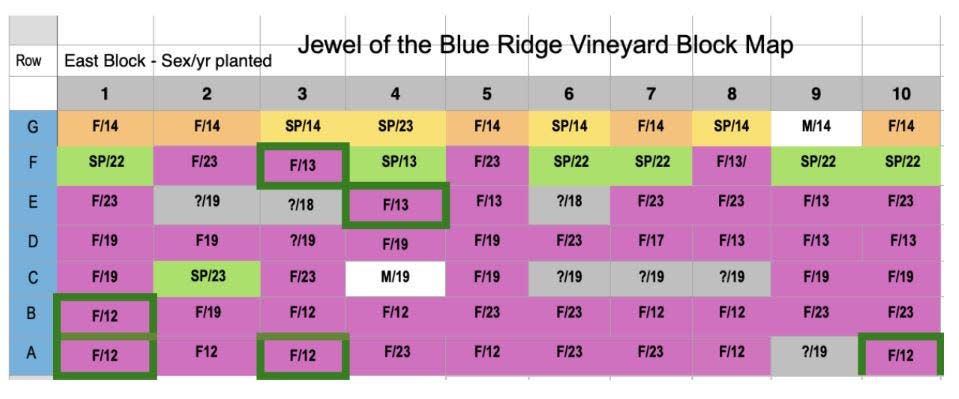The Mountain Grapevine: Tips on vineyard layout

You have decided which grapes to grow, tested your soil and made the necessary amendments. Time to do some planning on how your vineyard should be laid out.
Thinking ahead, you want to make sure you have the proper spacing between rows for easy access for mowing. Most muscadine vineyards have 8 to 12 feet between rows and 20 feet between vines in each row. The row spacing depends upon the slope — steeper slopes can have shorter spacing between rows so the vines do not shade the row uphill/behind the row in front. Also make sure you leave room at the ends of your rows for turning around when mowing or hauling pruned canes and grapes. Keep in mind that 1 acre of muscadine grapes requires about 200 vines with no chemical spraying.
Vinifera grapes are planted about 500-600 vines per acre and will require chemical spraying every 10 days to two weeks throughout the growing season. Yet muscadines will produce about 8 to 12 tons per acre compared to about 3 tons per acre for vinifera.
Carefully observe any nearby trees to your vineyard site. Grapes do not grow well in shaded areas. The wild muscadines of Madison County actually will grow up a 90 feet tall tree reaching for sunlight. If you live in a particularly windy location, remember that some wind protects grapes against mold and mildew. Too much wind will shut stomata (tiny entranceways that lets carbon dioxide into, and oxygen out of a leaf), causing the vine leaves to stop respiring temporarily. A wind break row of trees at a distance that will not shade the grapevines will be a plus for reducing wind.
Think about the fencing that may have to be installed for keeping out critters. Think carefully about where you will install gates for access to your vineyard. Make sure to make room for your mowing equipment and tractor maneuvering to and from the rows. And electric fences will need access to electricity for the fence charger. Think about the location of any switch needed to shut off the fence when necessary. It is not so handy to have to walk 100 yards away to shut off your electric fence.
Be especially careful to not allow walnut trees to grow within 100 feet of your grapevines. The black walnut tree secretes a chemical from its roots, fallen leaves, and husk of the black walnut known as juglone. This chemical gives the black walnut tree an allelopathic effect, killing certain plants that are within its canopy and roots. Think about it, if a tree can kill all surrounding plants, then it gets all the sunlight and soil nutrients. Research has determined that over 40 common vegetables, flowers, vines and trees that cannot survive being near black walnut trees. Among them are grapes, blueberries, blackberries, apple trees, potatoes, tomatoes, peppers, and rhubarb. So, if you remove a black walnut tree and want to start a garden or vineyard, fear not! There are certain bacteria that can feed solely on juglone. Bacteria known as Pseudomonas putida was found to break down juglone rapidly if the soil was aerated. It is produced here in our state at Carolina Biological Supply Company and can be purchased online from Amazon and others for about $15, if you think juglone will be an issue for your vineyard.
I have worked in vineyards around the planet over the years and have made a few observations that are worth sharing. Grapevine rows that are vertical (up and down the hill) are very hard to work in and to harvest grapes. There are those who feel the vertical rows get better sun exposure for the grapevines. Research that I have read doesn’t seem prove it one way or the other. There is certainly more soil erosion in vertical rows. I personally find working in vineyards where the rows are planted horizontally (on the contour) are much easier to work and harvest grapes. Steep slopes in Europe actually have ski lifts to carry baskets of harvested grapes up the hill for loading into trucks ready to haul them to the winery. Those slopes are 60 to 70 degrees. There is an organization in Europe, CERVIM, that recognizes the increased difficulty in growing grapes on steep slopes and high altitudes. They call it “Heroic Viticulture” and issues a special label for wine made from those grapes that allows a slightly higher price at retail for the extra effort.
Thinking ahead, consider using a good cover crop like grasses, vetch, or clover. This will help slow the pace of erosion, add nutrients to soil, attract beneficial insects and may choke out potential weed growth. Keep in mind it will take six years for muscadine grapevines to reach full maturity and production (seven years for vinifera). You can grow some annual crops in the rows between the vines to allow some income while you are waiting for the grapevines to get mature.
There are some areas that may benefit from providing irrigation for grapes. Katuah muscadines have done very well using the amount of rain that falls out of the sky here in the mountains. If you do decide to use irrigation you can feel good that grapes use the least amount of water of many other common crops. For example, 73 gallons of water are spent in the production of 1 pound of grapes compared to 124 gallons for 1 pound of French fries, 213 gallons for 1 pound of refined cane sugar, 300 gallons for 1 pound of rice, 396 gallons for 1 pound of eggs (51 gallons/egg), 519 gallons for 1 pound of chicken, 719 gallons for 1 pound of pork, 1,800 gallons for 1 pound of beef, and 2,269 gallons for 1 pound of coffee beans. Note that irrigation on vertical rows presents a unique engineering problem of higher flow rate at the lower end of a row. Pay attention to the distribution of water on steep hills by using adjustable irrigation drip heads. Using a water filter near your water source will prevent blockage of the irrigation heads.

Finally, you should keep a plot map of your vineyard (even a backyard one) showing where each vine is planted, when it was planted, and the name of the vines (especially if you have several grape varieties planted.) Identify each row of vines with a letter and each vine in the row with a number.
Chuck Blethen is a Madison County vigneron, author, lecturer and co-owner of Jewel of the Blue Ridge Vineyard & Walapini Nursery. He is the VP Public Relations for the French Broad Vignerons of WNC. He can be reached at Chuck@JeweloftheBlueRidge.com or 828-606-3130.
This article originally appeared on Asheville Citizen Times: Chuck Blethen's Mountain Grapevine: Tips on vineyard layout

